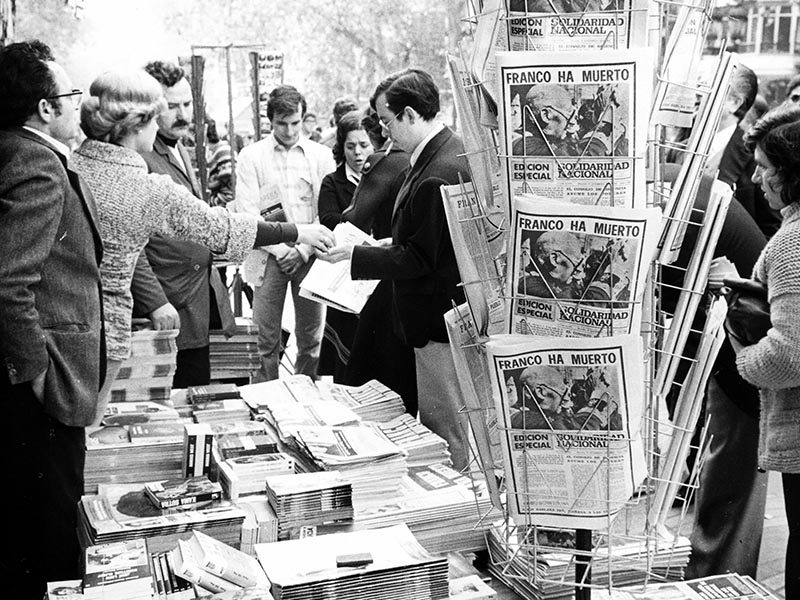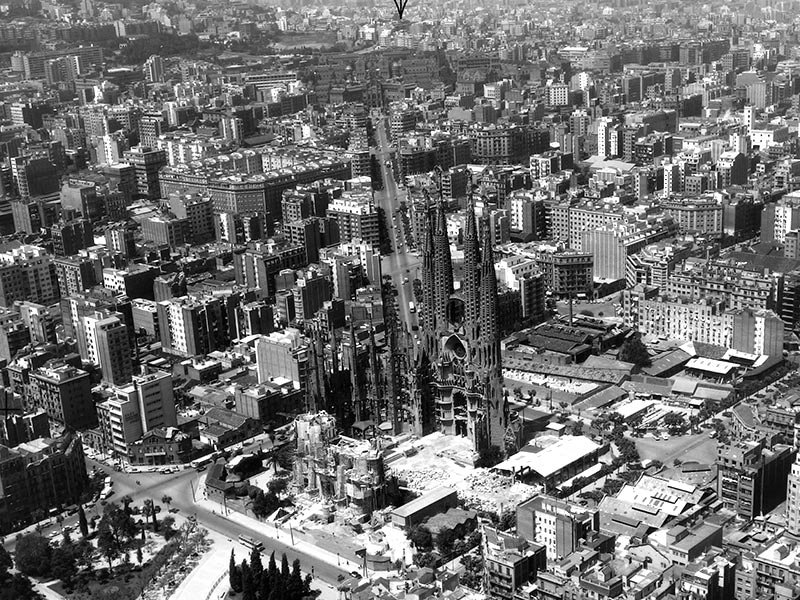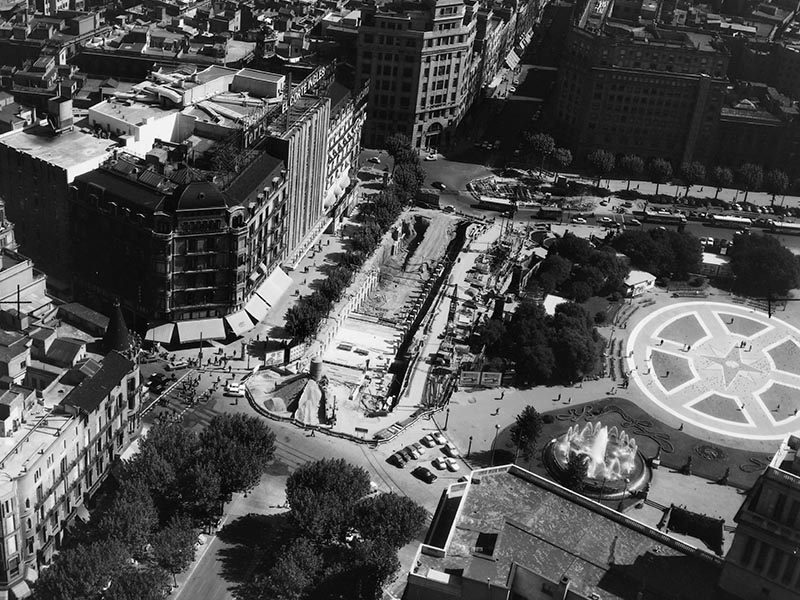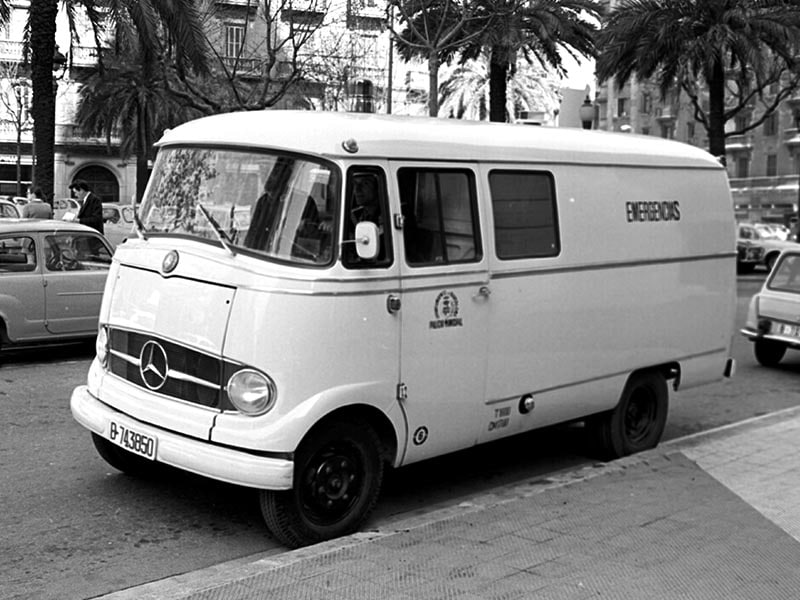Dictablanda (1960 - 1975)

1975 – Newsstand with papers announcing Franco’s death.
Josep Simo explains why he turned his back on politics.
I remember the disappointment they had. They all expected, at least those who were here, that once the [Second World] War was over Franco was over. Not only that, but also the great disappointment in my life, and there’s when I was done with all this stuff, was when I saw when I saw Eisenhower hugging Franco. For me, I don’t know, if the Americans see this, it was so hurtful for me, so sad, so disappointing and depressing, that it’s made it difficult for me to get Americans.

1966 – Panoramic view of Sagrada Familia.
Eduard Miralles discusses Vatican II’s effect on Spain.For example, ever since the II Vatican council mass and religious ceremonies are carried out in Catalan, despite the Francoist regime not liking it. Before the II Vatican, mass were in Latin and with their backs on the community, the believers, the attendees. That is, he was a man looking at the altar, looking at the holy images, so with their backs on the public speaking Latin. I think that the great contribution of the II Vatican council is that many religious practices are secularized and at the same time suggests a different position for the church elsewhere, untied from the civil and military power. That, of course, has an obvious impact and in our case the repercussion is that these movements, more committed with democracy, of religious orders, chaplains, etc. begin to act with more room for maneuver. Shortly after, a new concordat is signed between the Spanish state and the Vatican church which, in summary, breaks the bond that had almost been of connivance of the church regarding the state. Liturgies are modernized too. We were saying that they begin performing mass in Catalan – also in Spanish, because it used to be in Latin. Non liturgic music is introduced in the religious rites, for example the whole deal of the spiritual songs of American and Anglo-Saxon origin. There’s undoubtedly an opening. The chaplains dress… the clergyman appears, which is a… the cassock disappears, well, there’s a certain opening that will continue.

1966 – Construction underway near Plaça de Catalunya on parking lot beneath Carrrer de Pelai.
Eduard Miralles discusses Vatican II’s effect on Spain.For example, ever since the II Vatican council mass and religious ceremonies are carried out in Catalan, despite thOne of those stories that was told to me by one of the most important teachers I’ve had, Pilippe Gaulier, who was my teacher in London and Paris, is related to Franco. He’d say that when Franco died he was in France with some friends of his that were clearly leftists. They filled up a car with champagne and went to Barcelona to celebrate. It’s closely related with this moment of euphoria, collective craze that was lived when Franco died, that people went to the streets to celebrate. And he came from France with his friends. And he’d tell the whole class the feeling of pleasure and complete insanity and also fear and danger. Because Franco had died, but the regime was still on. He made the whole trip, from Paris I think, with the car full of champagne to be able to celebrate the death of the dictator. And that tells much of the euphoria that was lived not only here, but outside as well. This was felt as an oppression, a crime against liberty. Specially art, the first one to suffer in dictatorships, specially right-winged ones.

1966 – Assembly of students at the Captuxins de Sarrià

1975 – Cars heading down Diagonal over Easter.
Artist Xefo Guasch discusses the military police force known as The Grays. Those were the years of the ‘grises’ [lit. grey ones]. I studied architecture, I’m an architect. I studied architecture and it was a bit hard in universities, there was a year that there were almost no classes. And another year that you always had a grey clad man, who was a national cop, in each classroom. The year we had no clases, classes would start, but then the ‘grises’ came and starting hitting people and we the ‘grises’ as well. Then with my sister, who was a convinced communist. I was more anarchist. There were demonstrations on the streets quite often. You’d go there, the ‘grises’ would came and bam, bam, bam, handing out smacks.

1966 – Caputxinada. Student Democractic Union of the University of Barcelona.
Meritxell Campmany discusses the challenges women faced under Franco. From a legal perspective, women weren’t considered citizens with full rights during Franco’s reign. That meaning, a woman couldn’t have her passport done on her own, couldn’t open a bank account, and she needed her father’s permission to get married depending on the age. My mother explained it to me, the fact that they were not able to open a bank account. Until the end of the seventies, a woman couldn’t go to the bank and open a bank account without her husband’s permission. Neither have a passport. This is the main difference during Franco’s reign and before democracy.
Robert Surroca discusses the FNC’s clandestine efforts to fight the regime. We need to bring it forward. In 1965, it was the 25th anniversary of the execution of the president Companys. The FNC were always devoted to the president Companys, for the sacrifice he made, and for the dignity he showed towards the firing squad. So much so that the pamphlet made in 1945, and in the exile in France in 1950 by the FNC was called “Per Catalunya” [For Catalunya]. Companys’ last words. We didn’t want to forego the 25th anniversary. That thing with milestone anniversaries: 25th, 50th, 75th and so on. We always did manifestos and paintings. There was a biography made in Paris. The representative of the FNC in Paris, printed it offset. We entered it clandestinely through the mountain, and handed it out profusely. The same thing was done in 1968 with Francesc Macià. A biography, logically, made in France, and entered here clandestinely, and handed out profusely. I have both of them here. The cover of Company’s biography is amazing. Pause. These are both publications. As I told you, this was made in Paris and entered here with photographies of them, clandestinely. From 1963, I took charge of the organization’ clandestinity machine: the press, propaganda distribution and so on. I created the clandestine border of frontiers. We started with papers and we ended up crossing everything. In 1965, the magazine was not finished, but we made this cover with gummed paper. We stuck it up everywhere we could. Something curious happened. Franco once came to Barcelona and taxis had his portrait on the back of the car. You’ll find this on the press. I’m not sure I have it. We came out, and with a few remaining posters, around 40 or 50, we daubed the taxis that had Franco’s picture and were parked without the driver. The thing is that, the driver, saw that he had a picture of the back of his car and so he started the vehicle without realizing what we had done. Someone told him at the end. He was terribly busy then, the glue was extraordinary.

1964 – Barceloneta Beach in Barcelona.

1970 – Municipal Police Van.
Jordi Roselló discusses why Spain is Different was more than an ad campaign. Yes, it was shocking because, in a way, people who came from outside represented for us that they were more free. People with a freedom of movement and some abilities that we didn’t have. The thing is that, since they were foreigners, you don’t assimilate. These are the foreigners, us here from the country are different. There was that tag line, “Spain is different”, and in a way we had accepted it. The miniskirt, the bikini, it was all an outrage. But we need to understand that one thing was the foreigners and the other the locals. If a French-woman, an English-woman, a Swedish-woman wears a miniskirt, it’s just a Swedish-woman. But the locals had to be different. Yes, it was by law. I remember going with some friends to the beach to do top less and the ‘Guardia Civil’ would come and make them cover themselves. It wasn’t just tradition. There was also the moral and popular censorship too. Against nudism, there was people. But there were also laws that restricted freedom in the dress they wore.
